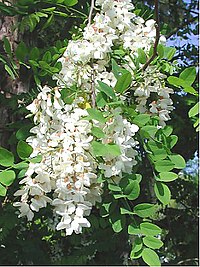
Photo from wikipedia
Rédei K., Csiha I., Rásó J., Keserű Z. (2017): Selection of promising black locust (Robinia pseudoacacia L.) cultivars in Hungary. J. For. Sci., 63: 339–343. In Hungary the black locust… Click to show full abstract
Rédei K., Csiha I., Rásó J., Keserű Z. (2017): Selection of promising black locust (Robinia pseudoacacia L.) cultivars in Hungary. J. For. Sci., 63: 339–343. In Hungary the black locust (Robinia pseudoacacia Linnaeus) is one of the most important exotic stand-forming tree species growing mostly under unfavourable ecological conditions. Considering the climate change effects its importance is increasing also in many other countries. As a result of a selection programme several black locust cultivars have been improved for setting up cultivar trials. In the paper four black locust cultivars were evaluated in Central Hungary under arid hydrological and brown forest soil conditions. Significant differences (P < 5%) were found in height, DBH, mean tree volume and average stem form value (SFV). At the age of 35 years the cultivar “R.p. Jászkiséri” appeared to be the most promising one for yield production and “R.p. Zalai” and “R.p. Nyírségi” for SFV.
Journal Title: Journal of forest science
Year Published: 2017
Link to full text (if available)
Share on Social Media: Sign Up to like & get
recommendations!